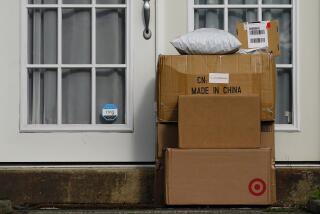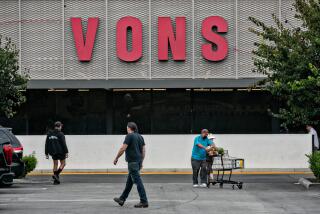Online retailers try to make the return process less annoying
- Share via
Buying something online takes a single click. Returning it? That’s not so seamless.
A growing number of online retailers, from e-commerce giant Amazon to small apparel and footwear brands, are teaming up with bricks-and-mortar chains to try to make returns less of a hassle — or at least no worse than a return to a traditional store.
“If people can’t see it or touch it [when they first buy it], they want the option to return it,” said Scott Rankin, principal at KPMG Strategy in the retail sector, of online purchases. “Sometimes they want to do it in a physical store because it’s just easier.”
With the holidays fast approaching, in-store returns programs are about to undergo a major test. U.S. consumers are expected to spend nearly $144 billion online this holiday season, up 14.1% from last year, according to Adobe Analytics.
But after a flood of packages lands at shoppers’ doorsteps, millions of unwanted items get sent right back. Delivery company UPS said it expects to handle a record-breaking number of returns this holiday season, with more than 1 million return packages expected to be shipped each day in December, peaking at an estimated 1.9 million packages on Jan. 2.
Customers can return many items bought on Amazon at any Kohl’s store after the retailers expanded a test of the returns service, initially offered at 100 Kohl’s stores, earlier this year. Delivery companies UPS and FedEx are partnering with chains like CVS and Walgreens to give shoppers more places to pick up and drop off packages.
Even some smaller online brands now offer in-store returns through Happy Returns, a Santa Monica-based company that lets shoppers return items from more than 300 online brands at more than 700 locations nationwide, mostly in malls and national chains like Paper Source and CostPlus World Market.
Companies like women’s apparel brand Revolve and footwear brand Rothy’s tout easy returns on their websites. Of in-person returns with Happy Returns, Revolve’s website says, “No receipt, return label or shipping box necessary! You just provide your email address or order number and your refund will be initiated immediately.”
For stores accepting other brands’ returns, it can be a way to get new customers in the door. Online retailers, meanwhile, know hassle-free returns can make customers more confident about clicking “buy.”
Companies like Amazon already have been giving customers options when it comes to sending back unwanted items, ranging from a traditional visit to the post office to dropping off a boxed-up return at one of its delivery and pickup lockers. But the most seamless options, which let shoppers skip steps like printing labels or packing up boxes, weren’t as widely available before partnerships with national retail chains.
In-person returns generally mean quicker refunds, which seems to be the biggest attraction for shoppers, said Happy Returns co-founder and Chief Executive David Sobie. But they also like being able to skip the “arts and crafts project” of prepping items for shipment, he said. Happy Returns gives customers refunds on the spot — no box required.
“For a number of years it was all about delivery and getting things fast and free, and now that focus has shifted to returns,” he said.
Consumers can still be reluctant to buy items sight unseen, especially goods like apparel and footwear, where fit is key. More than half of consumers have opted not to purchase an item because the return policy wasn’t flexible enough, according to a survey by Optoro, a company that works with retailers to process returns.
Dealing with returns isn’t cheap for online brands, so they don’t want to encourage customers to purchase items they’re unlikely to keep. But most companies understand some customers just won’t buy unless they know sending an item back will be simple, Rankin said.
Stores choosing to accept other brands’ returns see it as a way to get more customers in the door.
Kohl’s Chief Executive Michelle Gass said during a recent call with investors that the Amazon partnership seemed to be attracting new, younger shoppers.
At Paper Source, most of the people returning online purchases through Happy Returns are first-time customers, said Jenica Myszkowski, the company’s chief operating officer.
Even consumers who already shopped at a retailer might make an extra visit for a return, like Kimberly Hewlett, 29, who made a trip to a Kohl’s outside her neighborhood to return an air filter she bought on Amazon.
“It’s just easier, and you get a coupon,” she said.
That doesn’t mean everything always goes smoothly.
Lance Schart, 48, of Libertyville, Ill., said he usually takes Amazon returns to Kohl’s and was caught by surprise when told one purchase wasn’t eligible to be returned at the store. He wound up making an extra trip to UPS.
Returns can also pose extra challenges for stores that have volunteered to accept items on behalf of other brands.
Neighborly, a home goods and gifts shop in Chicago, has been a Happy Return dropoff location since 2017 and has seen returns bring new shoppers into the store.
But as more online retailers began using Happy Returns’ service, the volume of returns has gotten tougher to keep up with, especially during transitions between seasons when people tend to update their wardrobe, said manager Audrey Plank. Sobie said Happy Returns has been processing about 10 times the number of returns this year as it did in 2018.
“But they’re adding locations, so as more open in the city, it will alleviate the pressure on us,” she said.
Paper Source’s Myszkowski said Happy Returns works with them to schedule more frequent pickups at stores that get lots of returns — as often as two or three times a day at some locations during the holidays, she said.
Paper Source and Happy Returns are also testing self-service kiosks at two stores in Los Angeles that could lighten demands on store employees. In addition to making sure customers find the kiosks easy to use, Happy Returns will be testing shoppers’ honesty and whether extra checks are needed to ensure customers actually leave their returns with the kiosks, Sobie said.
Delivery companies like UPS and FedEx are also trying to make dealing with packages easier by letting customers pick up and drop off orders and returns at retailers including Michaels, CVS and Walgreens in addition to their own locations, although customers still need to box up items themselves.
FedEx lets customers returning items to certain retailers print shipping labels at some Walgreens stores, so the customer doesn’t need to do it at home. The service was available at most stores by Thanksgiving, and the rest in the following weeks.
When the retail partnerships are fully rolled out, both UPS and FedEx said 90% of the U.S. population will live within 5 miles of a location where they can pick up or drop off a package.
Most of the packages people drop off are returns, and they generally choose the location that’s closest or has the most convenient hours, said Scott Harkins, FedEx’s senior vice president of customer experience marketing.
“Really, it just comes down to convenience,” Harkins said.
Zumbach writes for the Chicago Tribune.
More to Read
Inside the business of entertainment
The Wide Shot brings you news, analysis and insights on everything from streaming wars to production — and what it all means for the future.
You may occasionally receive promotional content from the Los Angeles Times.










